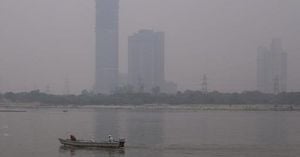Norway’s stark warning about Russia’s growing military presence in the Arctic has cast a fresh spotlight on one of the world’s most sensitive—and potentially volatile—strategic flashpoints. On October 26, 2025, Norwegian Defence Minister Tore Sandvik revealed that Russia is not only reinforcing its Arctic military presence on the Kola Peninsula but is also intensifying the deployment of nuclear weapons, new frigates, and advanced submarines, all while testing hypersonic missile systems. The implications of these moves ripple far beyond Norway’s borders, raising alarms from Washington to London and Ottawa.
According to Newsweek, Sandvik described the Russian buildup as a direct threat that extends well beyond regional borders. "Russia is building up on the Kola Peninsula ... where one of the largest arsenals of nuclear warheads in the world is located. [The nuclear weapons] are not only pointed towards Norway, but towards the U.K. and over the pole towards Canada and the U.S.," Sandvik stated in an interview with The Daily Telegraph. The Kola Peninsula has long been recognized as the core of Moscow’s strategic deterrence and its second-strike capability, a fact that is now taking on renewed urgency.
What exactly is unfolding in the Arctic? Sandvik outlined that Russia’s buildup features not only new frigates and multi-role submarines but also the testing of nuclear-capable hypersonic missiles and nuclear-powered torpedoes. These developments, he said, ensure that Russia’s second-strike capability remains robust even as its conventional forces suffer losses in Ukraine. "We are the eyes and ears of NATO in this area," Sandvik emphasized, highlighting Norway’s critical role in monitoring the High North for the alliance.
The Norwegian minister’s concerns are not limited to new weapons platforms. He pointed to two strategic maritime choke points that have been monitored by NATO analysts since the Cold War: the Bear Gap, which lies between Norway and the Svalbard archipelago, and the GIUK Gap, stretching among Greenland, Iceland, and the United Kingdom. Both serve as crucial submarine transit routes into the North Atlantic. "Putin needs to establish what is called the Bastion defense. He needs to control the Bear Gap to make sure that he can use his submarines and the Northern Fleet. And he wants to deny [NATO] allies access to the GIUK Gap," Sandvik explained, underscoring the strategic logic behind the Russian moves.
The Kola Peninsula’s military facilities are not new, but the scale and sophistication of the current buildup are raising eyebrows. Moscow’s Northern Fleet, founded in 1733 and home to strategic nuclear submarines, has remained largely intact despite Russia’s heavy losses in Ukraine. Sandvik noted, "Even though Putin is losing heavily in Ukraine, he has lost 1 million soldiers, [but] the Northern Fleet is intact. And they are developing it. They have a new frigate and a new multirole submarine, developed just in the last two years. The most threatening thing about Russia right now is its submarines."
The timing of Norway’s warning is significant. Tensions between Washington and Moscow have escalated in recent weeks. President Donald Trump, responding to Russia’s refusal to commit to a ceasefire in Ukraine, announced a fresh sanctions package targeting Russian oil giants Rosneft and Lukoil. He also publicly dismissed a recent meeting with Vladimir Putin in Budapest as a "wasted meeting." These diplomatic and economic measures, layered atop the military realities in the Arctic, suggest a broadening of the confrontation that has, until now, been largely focused on Eastern Europe.
Strategic analysts have long viewed the Arctic as one of the world’s most sensitive nuclear flashpoints. The region’s remoteness, harsh climate, and sparse population have historically kept it out of the headlines, but its importance as a potential theater for global confrontation is increasingly recognized. According to Newsmax, Western officials see no indication that Russia intends to scale back its Arctic operations—especially if Ukraine receives longer-range U.S. or NATO missile systems such as Tomahawks.
Norway’s role as NATO’s “eyes and ears” in the Arctic is not just a matter of geography. The country’s advanced surveillance and intelligence capabilities, coupled with its proximity to Russian bases, make it uniquely positioned to monitor developments in the region. This responsibility, Sandvik suggested, is becoming ever more vital as the Arctic emerges as a key arena in the broader standoff between Moscow and the West.
The Bear Gap and GIUK Gap, while perhaps unfamiliar to most, are names that have kept NATO planners awake at night for decades. These maritime corridors are the gateways through which Russian submarines can slip into the Atlantic, potentially threatening transatlantic shipping lanes or even launching strikes against NATO nations. By reinforcing its presence and seeking to control these gaps, Moscow is signaling its determination to maintain—and, if necessary, project—its strategic power.
The sophistication of Russia’s new weaponry is another source of concern. Hypersonic missiles, capable of flying at speeds exceeding Mach 5 and maneuvering unpredictably, present a daunting challenge for existing missile defense systems. Nuclear-powered torpedoes, meanwhile, could potentially threaten coastal cities or naval installations far from Russian shores. The combination of these systems with upgraded ballistic submarine units gives Russia a diverse and resilient nuclear arsenal—one that is, as Sandvik warned, pointed at more than just Norway.
Despite Russia’s setbacks in Ukraine, Sandvik’s message was clear: the country’s naval and nuclear forces remain formidable. "The most threatening thing about Russia right now is its submarines," he reiterated, a sentiment echoed by security analysts across the alliance. The enduring strength of the Northern Fleet, even as other parts of Russia’s military have suffered, is a testament to Moscow’s prioritization of its strategic deterrent.
The escalation in the Arctic is not occurring in a vacuum. It comes at a time when the global security environment is in flux, with old certainties giving way to new risks. The Arctic’s melting ice is opening new shipping routes and resource opportunities, making the region more accessible—and more contested—than ever before. As Norway’s warning makes clear, the High North is now very much on the front lines of the emerging global confrontation between Russia and the West.
For now, all eyes remain fixed on the Arctic, where submarines slip silently beneath the ice and new weapons are tested in the cold, clear air. Norway’s message to its allies is simple: vigilance is more important than ever, and the stakes could not be higher.




